 The article of this site devoted to their reproduction mentions the courtship observed in some species of springtails. These nuptial dances attest, at the very least, to the existence of gestural communication probably using the tactile and/or visual perception of springtails. But it must be emphasized that the latter remains rudimentary or even non-existent in some species. In this case, when the latter operate ...
The article of this site devoted to their reproduction mentions the courtship observed in some species of springtails. These nuptial dances attest, at the very least, to the existence of gestural communication probably using the tactile and/or visual perception of springtails. But it must be emphasized that the latter remains rudimentary or even non-existent in some species. In this case, when the latter operate ...
Springtails anatomy and physiology
Communication in springtails
Setae and sensilles of springtails
 The full bristles and the sensory bristles (sensilla) play several roles, respectively that of protection or ornament and for the innervated bristles, the role of mechanical receiver but also for some of them that of chemoreceptor. In order to better understand the functional difference between a
The full bristles and the sensory bristles (sensilla) play several roles, respectively that of protection or ornament and for the innervated bristles, the role of mechanical receiver but also for some of them that of chemoreceptor. In order to better understand the functional difference between a
Elements of study of jumps
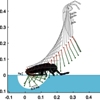 Not long ago, it was admitted that springtails did not master their jumps to the point of making it an ordinary means of locomotion. These jumps, resulting from an explosive relaxation of their furca, were then considered as an escape reflex random trajectories. However, chapter 24, devoted to the collophore, shows that this organ can be used as...
Not long ago, it was admitted that springtails did not master their jumps to the point of making it an ordinary means of locomotion. These jumps, resulting from an explosive relaxation of their furca, were then considered as an escape reflex random trajectories. However, chapter 24, devoted to the collophore, shows that this organ can be used as...
Eye plates of springtails
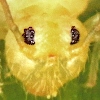 Springtails do not have compound eyes, as is the case with almost all insects. Their vision is made from a group of simple or ocellated eyes grouped in the ocular plates and whose number and disposition vary according to the species
Springtails do not have compound eyes, as is the case with almost all insects. Their vision is made from a group of simple or ocellated eyes grouped in the ocular plates and whose number and disposition vary according to the species
PAO - Post antennal organ
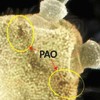 The postantennal organ or "PAO" (Post Antennal Organ) is a chemoreceptor sensory organ found in some springtails. However, families like the Entomobryidae do not have it and, for example, in some Sminthurididae, this organ takes the form of a small bulb shaped like an ankle ...
The postantennal organ or "PAO" (Post Antennal Organ) is a chemoreceptor sensory organ found in some springtails. However, families like the Entomobryidae do not have it and, for example, in some Sminthurididae, this organ takes the form of a small bulb shaped like an ankle ...
Biomimetic
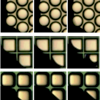
What is the relationship between a springtail and a pipeline ? The question may seem odd, which is why I am trying to provide some answers in this article inspired by a study1 conducted by researchers from the Science and Technology Division of King Abdullah University in Saudi Arabia...
Ventral tube - Structure and functions
 This article is a supplement to my article "Collophorus - ventral tube of springtails". It is inspired by work carried out by Chinese researchers (Chong-Guang Chen, Tong Chen, Bao-Zhen Hua, and Tao-Ruan Wa) from Yangling University (Shaanxi) ...
This article is a supplement to my article "Collophorus - ventral tube of springtails". It is inspired by work carried out by Chinese researchers (Chong-Guang Chen, Tong Chen, Bao-Zhen Hua, and Tao-Ruan Wa) from Yangling University (Shaanxi) ...
Cuticule of springtails
 The cuticle is with the springtails what the skin is to the human, but the comparison stops there because this thin film which covers the whole body of a springtail has astonishing properties. Regarding its constitution, if we refer to the right part of the diagram below,
The cuticle is with the springtails what the skin is to the human, but the comparison stops there because this thin film which covers the whole body of a springtail has astonishing properties. Regarding its constitution, if we refer to the right part of the diagram below,
Cryoprotective Dehydration
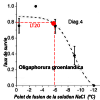 For 400 million years that springtails have been evolving on Earth, they have occupied a wide variety of niches. One of the reasons for their survival is their small size that allowed them to colonize interstitial soil, dead vegetation or other confined spaces.
For 400 million years that springtails have been evolving on Earth, they have occupied a wide variety of niches. One of the reasons for their survival is their small size that allowed them to colonize interstitial soil, dead vegetation or other confined spaces.
The furca - Jumping organ of springtails
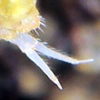
Morphology of Arthropleones and Symphypleones
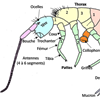 The head of the Arthroplean springtails is distinct from the thorax and surmounted by a pair of antennas possessing several articles. In addition to the mouthparts and antennas, the latter has three types of external sensory receptors
The head of the Arthroplean springtails is distinct from the thorax and surmounted by a pair of antennas possessing several articles. In addition to the mouthparts and antennas, the latter has three types of external sensory receptors
Antennas of springtails
 The antennas of springtails adopt various forms as shown by the images at the end of the article, but as for other organs their constitution, whatever the families, have similar characters or similar (among others four segments). They are particularly well endowed with sensory structures
The antennas of springtails adopt various forms as shown by the images at the end of the article, but as for other organs their constitution, whatever the families, have similar characters or similar (among others four segments). They are particularly well endowed with sensory structures
Physiological functions of springtails
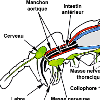 Springtails are animals ranging in size from approximately 0.12 mm to 17 mm. They have a head, a chest consisting of three segments and an abdomen that includes six. The head carries antennas, the thorax has three pairs of legs and the abdomen has a jumping organ called furca and other organs with specific functions
Springtails are animals ranging in size from approximately 0.12 mm to 17 mm. They have a head, a chest consisting of three segments and an abdomen that includes six. The head carries antennas, the thorax has three pairs of legs and the abdomen has a jumping organ called furca and other organs with specific functions
Collophorus - Ventral tube of springtails
 Also called ventral tube, it is located on the first abdominal segment (above, images made with an electron microscope) More or less elongated according to the group (generally longer in Symphypleones), it consists of a ventral tube and carries at its base a pair of thin-walled excretile vesicles
Also called ventral tube, it is located on the first abdominal segment (above, images made with an electron microscope) More or less elongated according to the group (generally longer in Symphypleones), it consists of a ventral tube and carries at its base a pair of thin-walled excretile vesicles
The legs of springtails
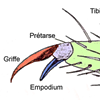 This illustration shows the end of an Isotoma leg (Entomobryomorph). There are three pairs, the legs are attached to the three thoracic segments. Springtails uses them to move, but also for other operations such as the toilet.
This illustration shows the end of an Isotoma leg (Entomobryomorph). There are three pairs, the legs are attached to the three thoracic segments. Springtails uses them to move, but also for other operations such as the toilet.
Reproduction of springtails
 Reproduction of springtails can, depending on the species, be sexed (male + female) or asexual (parthenogenesis). Considered primitive animals, some of them reveal evolved behavior, varied and adapted to various biotopes
Reproduction of springtails can, depending on the species, be sexed (male + female) or asexual (parthenogenesis). Considered primitive animals, some of them reveal evolved behavior, varied and adapted to various biotopes
Mouthparts of springtails
 The mouthparts are not visible because they are embedded in a cavity (This is among other features distinguishing springtails from insects). The species thus defined are described as enthroned. Oral parts play a very important role in the identification and classification of species
The mouthparts are not visible because they are embedded in a cavity (This is among other features distinguishing springtails from insects). The species thus defined are described as enthroned. Oral parts play a very important role in the identification and classification of species